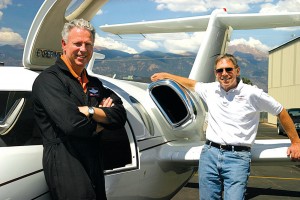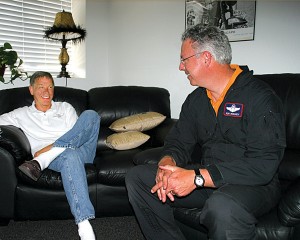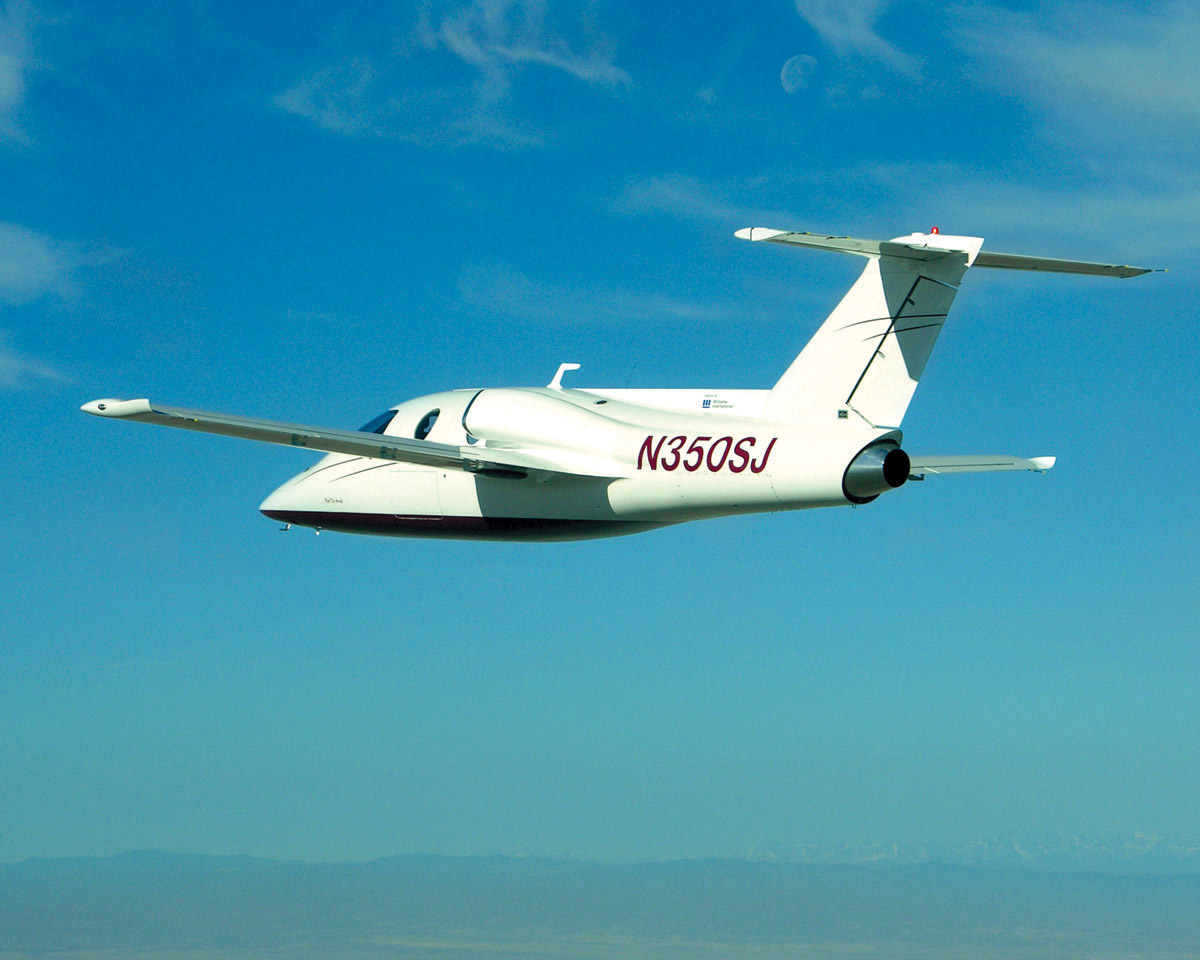By Jeff Mattoon,
At least a handful of people never believed that the Sport-Jet, engineered by Bob Bornhofen, would fly. But as occurs often in life and aviation, the pundits are once again wrong.
Early on the morning of May 12, the privately funded very light jet took off from Colorado Springs Municipal Airport (COS) for its official first flight. “Official” is an important distinction, because the day before, in high-speed taxi testing, the Excel-Jet Sport-Jet took to momentary flight between 65 and 70 knots.
What followed were a series of test flights through the weekend and into the following week with data confirming Bornhofen’s assertion that this aircraft will display incredible stability and power.
“Although I’m very pleased, I’m not surprised. You have to remember that we had over 500 flight hours with the Maverick (before he sold his interest in the company), where we did a lot of homework. There’s no new whiz-bang technology here,” beams Bornhofen.
Arguably, the Maverick was one of the first VLJs, or what Bornhofen likes to call “personal jets,” small jets designed for a single general aviation pilot, and not necessarily designed for air taxi use. The Maverick and others like it were somewhat ahead of their time—or more accurately, ahead of the new-technology small-engine’s time. The twin-engine, kit-built Maverick utilized GE T58s, which were larger and heavier than the powerful, single Williams FJ-4A that propels the Sport-Jet. Speaking of Williams engines, the small, skunkworks-like Excel-Jet team had the FJ33 installed and ready for flight just two weeks after taking delivery from the engine manufacturer.
Those who know Bornhofen never doubted—less from loyalty than from history—that the aeronautical engineer possesses a dogged tenacity that will not be denied. As Bornhofen and test pilot Ron McElroy discuss the day’s flight, Bornhofen is all grins and is noticeably pleased.
“This aircraft is really like a BB out of a slingshot. In the taxi tests, it was immediately apparent we had plenty of thrust,” says McElroy. “Pitch forces are very light with minimum adjustment needed for elevator and ailerons. The Sport-Jet is smooth and stable; at a 20 to 25 degree bank it just sets there. Landings were performed at 80 knots over the threshold (touching down at 75 kts), with flaps, in approach position and the air brakes deployed.”

Test pilot Ron McElroy (left) and Excel-Jet owner Bob Bornhofen relax after a successful morning of flight-testing the Sport-Jet.
The Sport-Jet is the 101st aircraft McElroy has flown—a personal milestone. As McElroy and Bornhofen sit in the debriefing room, they bounce facts of the past weekend’s flights off each other like they were paddling a ping-pong ball back and forth.
“Gear up on the fifth flight, less than a week, seven flights,” serves Bornhofen.
“250 knots true airspeed by the fifth with only 52 percent of power,” McElroy returns.
“Reduced power for takeoff, rotation at around 1,200 feet, and we were over 3,000 AGL by the end of the runway!” Bornhofen answers.
“And that’s at 6,000 feet in Colorado Springs!” quips McElroy.
In his exuberance, Bornhofen is quick to return the topic to the important basics: that the Sport-Jet is designed for the individual general aviation pilot moving away from a propeller-driven aircraft while offering a high degree of insurability. In fact, according to Excel-Jet, the company has confirmation from the largest GA insurance broker in the U.S. that their approach “will contribute significantly to the insurability of the aircraft when operated by nonprofessionals.” Something that Bornhofen is convinced will prove an aggravation to other VLJ manufacturers, or more accurately, the pilots who wish to become insured in those other aircraft.
“We wanted to provide the GA pilot with a true performance jet aircraft in an insurance-friendly platform. Our flight-testing shows we’re achieving that goal,” states Bornhofen.

02 Sport-Jet designer Bob Bornhofen (left) and test pilot Ron McElroy discuss the day’s flight. They both have a lot to be pleased about.
McElroy goes a step further, believing, based on his military experience, that zero-hour pilots may one day start their training and solo in the Sport-Jet. Because of his experience with the Maverick—which acting as proof of concept of sorts—Bornhofen believes that moving from flight-testing of the Sport-Jet to the creation of a conforming aircraft, and then on to certification, will take a short period of time. He stopped short of predicting a certification date, having felt the sting of the all-too-common unexpected delays in the past.
After setting first flight date estimates last year, his Polish wing manufacturer required “an additional sum before delivery.” Undaunted, Bornhofen shot the wing plans to Fort Collins, Colo.- based Scion Industries. In just 70 days, they delivered. Bornhofen doubts whether other upstart VLJ manufacturers with their huge budgets and managerial hierarchy could move that quickly.
With optimism, Bornhofen moves forward.
“We expect to move through flight testing and into certification with the same speed as initial development,” he says.
The 4,900-lb. Sport-Jet is expected to sell for $1.15 million, cruise at FL25, offer a range of 869 nautical miles and seat four to five people. Its max cruise speed is expected to be 375 KTAS.
For more information, visit [http://www.sport-jet.com].












